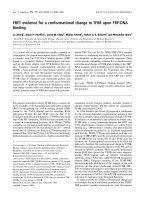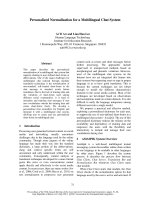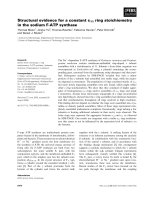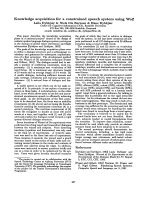Báo cáo khoa học: No evidence for a role in signal-transduction of Na+/K+-ATPase interaction with putative endogenous ouabain potx
Bạn đang xem bản rút gọn của tài liệu. Xem và tải ngay bản đầy đủ của tài liệu tại đây (153.75 KB, 4 trang )
HYPOTHESIS
No evidence for a role in signal-transduction of Na
+
/K
+
-ATPase
interaction with putative endogenous ouabain
Otto Hansen
Department of Physiology, Aarhus University, DK-8000 A
˚
rhus C, Denmark
A cascade of events (signal-transduction), mainly seen in rat
cardiac myocytes and renal cells, is thought to occur after
ouabain interaction with a minor fraction of Na
+
/K
+
-
ATPase. A higher intracellular Na
+
concentration followed
sodium pump inhibition by ouabain with a subsequent
gradual increase or oscillations in intracellular Ca
2+
con-
centration. Whether this increase in intracellular Ca
2+
concentration is part of the cascade, a result of the cascade or
a totally independent phenomenon are conflicting interpre-
tations that are discussed. At best, however, the cascade is
initiated by ouabain concentrations several orders of mag-
nitude higher than the measured plasma concentrations of
putative endogenous ouabain. The experimentally high
ouabain concentration may be critical for another reason.
Most tissues contain various isoforms of the catalytic
a-peptide of Na
+
/K
+
-ATPase with an individual sublocali-
zation and, in rats, with different ouabain-sensitivity. The
almost ouabain-insensitive a
1
-isoform of Na
+
/K
+
-ATPase
is essentially unaffected by the high ouabain concentration,
whereas ouabain-sensitive a-isoforms, possibly confined to
membrane structures near cytosolic microdomains and
Na
+
/Ca
2+
exchangers, may be totally blocked. Classifying
endogenous ouabain as a physiological inducer of the sign-
aling system on this background seems hazardous.
Keywords: a isoforms; endogenous ouabain; Na
+
/K
+
-
ATPase; ouabain-like factors; OLF; ouabain-insensitive;
signal-transduction; sodium pumps.
Introduction
Ouabain and other cardiac glycosides have been known as
specific inhibitors of the sodium pump and the purified
Na
+
/K
+
-ATPase ever since the very first observation of
inhibition of the sodium pump of red cells [1] and inhibition
of the isolated Na
+
/K
+
-ATPase from crab nerves [2].
Ouabain inhibition of both phenomena was in fact one of
the important criteria for the identity between the sodium
pump and the purified, though still membrane-embedded
Na
+
/K
+
-ATPase [3]. Before the inhibitory mechanism had
been appreciated, the pharmacological action of cardiac
glycosides in congestive heart failure had been known for
centuries. The amazing interaction of a plant-derived drug
with a membrane receptor of animal cells led to speculations
of endogenous mammalian digitalis-like factors (EDLF,
reviewed in [4]). The occurence of a ouabain isomer (often
called ouabain-like factor, OLF) or even ouabain itself in
normal plasma seemed to support these claims [5].
Goto et al. [4] pointed out that a number of criteria
should be fulfilled for substances to be considered as
candidates for EDLF. Inhibition of Na
+
/K
+
-ATPase, as
exhibited by, e.g., unsaturated fatty acids [6] and lyso-
phospholipids, does not suffice. Neither does EDLF
immunoreactivity, as many steroids, lipids and bile acids
cross-react with antibodies to cardiac glycosides [4]. Hansen
[7] emphasized the vast pool of Na
+
/K
+
-ATPase in skeletal
muscles, and thus receptors for EDLF/OLF, compared to
the measured low secretion rate of OLF from the adreno-
cortical gland.
A novel role of ouabain in signal-transduction
Recently, however, a novel physiological role was attributed
to ouabain and thus to endogenous ouabain in addition to
the inhibition of Na
+
/K
+
-ATPase traditionally associated
with the pharmacological action of cardiac glycosides.
Based mainly upon experiments with renal cells [8] and
ventricular myocytes [9–11], in both cases isolated from the
rat, ouabain was suggested to have a hormonal role in signal
transduction in addition to the traditional role of Ca
2+
accumulation due to pump inhibition, a reduced Na
+
gradient and reduced Na
+
/Ca
2+
exchange resulting in a
positive inotropic effect in susceptible tissues (for references
see [12]). Generation of the cascade of secondary events was
associated with transient oscillations [8] or a more gradual,
in some cases independent [10] increase in intracellular Ca
2+
concentration [9–11]. The original observations were
accompanied by an enthusiastic commentary in Nature
Medicine [13] and a minireview in Eur. J. Biochem. [14].
These authors [13,14] added a more comprehensive and
Correspondence to Otto Hansen, Department of Physiology,
Aarhus University, Ole Worms Alle
´
160, DK-8000 A
˚
rhus C,
Denmark. Fax: + 45 86129065, Tel.: + 45 89422806,
E-mail: oh@fi.au.dk
Abbreviations: EDLF, endogenous digitalis-like factor; ER, endo-
plasmic reticulum; MAPK, mitogen-activated protein kinase; NF-jB,
nuclear factor kappa B; OLF, ouabain-like factor, a ouabain-like
isomer; ROS, reactive oxygen species; SR, sarcoplasmic reticulum.
(Received 16 January 2003, revised 26 February 2003,
accepted 4 March 2003)
Eur. J. Biochem. 270, 1916–1919 (2003) Ó FEBS 2003 doi:10.1046/j.1432-1033.2003.03554.x
hypothetical cascade of events initiated by ouabain occu-
pancy of a small fraction of the sodium pumps. One of them
had advocated the role of EDLF for years [15].
Possible pitfalls for a novel role of cardiac glycosides
It is generally accepted that the sodium pump and the
external aspect of the purified, though still membrane-
embedded, Na
+
/K
+
-ATPase is the specific receptor for
cardiac glycosides, that the binding can be described as a
simple bimolecular (second order) reaction with a stoichio-
metry of 1 : 1 [12] and that identified amino acid residues
of the external loops of the hydrolytic a-peptide are involved
in ouabain sensitivity [16]. Caution is needed, however,
before classifying OLF or even ouabain as normal steroid
hormones functioning in signal-transduction pathways
under physiological conditions. The described individual
steps [8–11], that may be part of a cascade of events, are not
questioned under the conditions of the experiments but
serious flaws and failures may invalidate the interpretation
and the supposed physiological implication [13,14]. First is
the questionable existence of OLF that at best is at an
insignificantly low plasma concentration compared to the
huge pool of sodium pumps in the mammalian body. Of
equal importance is the often ignored fact, that the rat,
contrary to most other mammalian species, contains an
almost ouabain-insensitive isoform of Na
+
/K
+
-ATPase.
In most tissues, the Na
+
/K
+
-ATPase is a heterodimer
consisting of a 112 kDa hydrolytic a-peptide, through
which the vectorial transport of Na
+
and K
+
takes place,
and the small a-glycoprotein (35 kDa for the protein) with
chaperone-like function. Four isoforms of the a-peptide
have been described (one in testes). In most mammalian
species, Na
+
/K
+
-ATPase, irrespective of isoform compo-
sition, has a very high affinity to the specific inhibitor,
ouabain. This is true except for a few rodent species (mainly
the rat) in which pumps containing the a
1
-isoform have an
extremely low affinity for cardiac glycosides. Most rat
tissues moreover have a mixture of ouabain-insensitive and
ouabain-sensitive isoforms, of which the latter may have a
sublocalization critical for the observations looking at
ouabain as a signal-transducer.
Experiments pointing to a pivotal role of ouabain
in signal-transduction
In the following, more details are discussed concerning the
experiments with ouabain that led to the explicit formula-
tion of a cascade of events. Based mainly on observations
with rat myocytes, additional roles in signal-transducing
function of ouabain’s interaction with Na
+
/K
+
-ATPase
were attributed to tyrosine protein kinase, Src, epidermal
growth factor receptor and the Ras/MAPK (mitogen-
activated protein kinase)-dependent cascade with NF-jB
activation and generation of reactive oxygen species (ROS)
[9–11]. In each case, the cascade is hypothesized to be
elicited by the interaction of a minor fraction of ouabain-
altered Na
+
/K
+
-ATPase with neighbouring proteins (Src,
growth factor receptors and Ras), i.e. by protein–protein
interaction. In myocytes, the events from signal-transduc-
tion were interpreted as independent of a small increase in
[Na
+
]
i
and also occasionally independent of the subsequent
increase in [Ca
2+
]
i
[10], whereas in other publications,
activation of the Ras/MAPK cascade was interpreted as a
prerequisite for the increase in [Ca
2+
]
i
[11]. Nevertheless,
simple inhibition of pump function, by lowering the
extracellular K
+
concentration, was able to mimic ouabain
with respect to the cascade in rat cardiac myocytes [9].
In rat renal cells [8] on the other hand, ouabain
interaction with a minor fraction of the Na
+
/K
+
-ATPase
gave rise to the release of Ca
2+
from endoplasmic reticulum
(ER) and Ca
2+
influx via voltage-gated and calcium release-
activated calcium channels in the plasma membrane. The
resulting slow-vawe [Ca
2+
]
i
oscillations in turn were inter-
preted as activating the transcription factor, NF-jBthat,
after translocation to the nucleus, interacted with target
genes initiating growth and differentiation. Lowering of the
extracellular [K
+
] did not mimic ouabain in renal epithelial
cells as [Ca
2+
]
i
did not change with low extracellular [K
+
],
though an increase in [Na
+
]
i
was seen [8]. A possible
explanation in the latter case could be that pump inhibition
is counteracted by hyperpolarization rather than membrane
depolarization due to the increased K
+
gradient according
to the Goldman constant-field equation. The Na
+
/K
+
-
ATPase is indeed electrogenic, contributing in the order of
10 mV to the membrane potential due to the stoichiometry
of (3 : 2) Na
+
/K
+
-exchange by the pump. On the other
hand, according to the pump-leak model, the membrane
potential is not established exclusively by the pump.
The mentioned, often contradictory observations and
interpretations do not add to the credibility of the
hypothesis. The main objections to a normal signal-
transducing function of ouabain interaction with Na
+
/K
+
-
ATPase, however, are the following. To place this pheno-
menon into a normal physiological framework, the authors
[8–11] (a) more or less ignore the presence of a-peptide
isoforms of Na
+
/K
+
-ATPase with different ouabain
affinities in rats; (b) ignore the extremely high concentra-
tions of ouabain applied and (c) assume a similar role by
putative endogenous ouabain or OLF.
Ouabain-sensitive and -insensitive a-isoforms
of Na
+
/K
+
-ATPase in rats
All isoforms of the catalytic a-peptide of Na
+
/K
+
-ATPase
have similar, high affinity for ouabain [17] with K
d
in the
order of one or a few nanomolar [12,17]. An exception from
this general rule is the almost ouabain-insensitive a
1
-isoform
seen in rats ([for references, see [18]). In most tissues in the
rat, however, this a
1
-isoform, as well as the highly ouabain-
sensitive a
2
- (skeletal and heart muscle) and a
3
-isoform
(nerve tissue and brain) are present. The exception is the
kidney where more than 99.9% of the enzyme consists of
the ouabain-insensitive a
1
-isoform [19]. This explains why
large concentrations of ouabain (50–500 l
M
) are needed to
obtain Ca
2+
-oscillations in a reasonable fraction of the rat
kidney cells [8], though oscillations were seen in a few cells
exposed to 10–100 n
M
ouabain for 3 h. As ouabain binding
to Na
+
/K
+
-ATPase is a simple second order reaction [12],
3 h incubation at 37 °C does not seem reasonable for
obtaining equilibrium as demonstrated by the statement
that Ô…ouabain binding…is expected to increase as a
function of timeÕ [8]. However, irrespective of the lower or
higher concentration range employed, they are both far
Ó FEBS 2003 Endogenous ouabain in normal signal-transduction? (Eur. J. Biochem. 270) 1917
beyond the reported plasma concentration of the putative
steroid hormone ouabain or OLF (Fig. 1). In this context,
we are even ignoring the fact that Na
+
/K
+
-ATPase
containing the ouabain-sensitive a
2
-anda
3
-isoforms else-
where in the rat would have been totally blocked at
micromolar or sub micromolar concentrations of ouabain.
Plasma concentrations of putative endogenous ouabain
In another recent minireview in Eur. J. Biochem.[20].
endogenous ouabain was claimed to be a novel steroid
hormone and the adrenal gland the major place of synthesis
of ouabain. However, it is still much debated whether
ouabain or OLF really exist in mammalian blood and
tissues, and if they do, whether low level production from,
e.g. the adrenal glands would suffice [7,21]. In the original
publication by Hamlyn et al.[5]onOLFÔ…indistinguish-
able from the cardenolide ouabain…Õ they stated an immu-
noreactive plasma concentration of 80 ± 18 pmolÆL
)1
in
normal rats as measured by ELISA. OLF were quantified in
plasma from two strains of rat by another group in
collaboration with Hamlyn [21] by means of two independ-
ent assays, a radioimmunoassay using an anti-ouabain Ig
and an enzymatic assay using ouabain-sensitive Na
+
/K
+
-
ATPase from dog kidney. The concentration range of OLF
found in plasma was 25–27 pmolÆL
)1
in normotensive and
68–76 pmolÆL
)1
in Milan hypertensive rats, i.e., concentra-
tions almost 3–6 orders of magnitude lower than employed
in experiments focusing on signal-transduction [8–11], see
Fig. 1. Higher values based solely on immunoassays have
been reported [15] (e.g., during volume expansion in dogs or
strenous exercise in man, though still much lower than the
concentrations used for signal-transduction) while others
have been unable to detect immunoreactive OLF in plasma,
adrenal glands and tissues of man at all [22]. Endogenous
ouabain was a theme at the 10th International Conference
on Na,K-ATPase and Related Cation Pumps in Elsinore,
Denmark, in August 2002. The meeting of 250 specialists on
Na
+
/K
+
-ATPase and related topics didn’t lend much
support to the existence of endogenous ouabain and OLF.
Assigning ouabain a novel physiological role given this
background seems hazardous.
Distribution of a-isoforms of Na
+
/K
+
-ATPase
As to the observations at 100 l
M
ouabain with rat
ventricular myocytes (100 n
M
with HeLa cells) containing
a
1
-aswellasa
2
-isoforms of Na
+
/K
+
-ATPase the explan-
ation for the apparent signal-tranduction may differ [9–11].
In one of the papers [9] it is mentioned that the rat
a
1
-isoform is less sensitive to ouabain but not the significant
content of ouabain-sensitive a
2
in rat cardiac muscle
[23–25]. The ratio between the a
1
-containing insensitive and
a
2
/a
3
-containing sensitive Na
+
/K
+
-ATPase in rat cardiac
tissue is not well known as only the latter can be determined
in [
3
H]ouabain binding studies. In a membrane fraction
from cardiac ventricles of adult rats, high-affinity Na
+
/K
+
-
ATPase containing a
2
seemed to represent 26% of total
activity [25]. A similar distribution could be estimated by
using isoform-specific antibodies and Western blots to
which homogenates of rat cardiac ventricles had been
applied [26]. The a
2
-population of pumps should be totally
blocked by the 100 l
M
ouabain used in experiments with rat
ventricular myocytes [9–11]. Due to the preferential locali-
zation of the ouabain-sensitive pumps to membrane struc-
tures overlying junctional SR/ER [27], an alternative
explanation to an apparent signal-transduction role could
be a local rise in [Na
+
]
i
resulting in reduced Na
+
/Ca
2+
-
exchange locally. Cellular compartments with larger chan-
ges in intracellular Na
+
and Ca
2+
may thus be the result of
a ouabain interaction with subpopulations of Na
+
/K
+
-
ATPase [27]. An overall increase in intracellular Na
+
was
seen in the experiments with low concentration of extracel-
lular [K
+
] [8,9], that also mimicked ouabain with respect to
the cascade in cardiac myocytes [9].
Other implications of signal-transduction by ouabain
Finally, I would like to discuss that a great many studies on
rat wild-type, as well as mutant Na
+
/K
+
-ATPase, have been
carried out with mammalian cell lines transfected with
cDNA constructs encoding a ouabain-resistant a
1
-isoform
or derived ouabain-resistant a
2
-ora
3
-isoforms [28]. The
endogenous ouabain-sensitive Na
+
/K
+
-ATPase is
knocked-out by incubation of the cells in micromolar
concentrations of ouabain [16]. Were signal-transduction
of significance in this situation, the phenomenon should be
expected in those cells and the results interpreted accordingly.
Fig. 1. Ouabain affinities to rat Na
+
/K
+
-ATPase isoforms and actual
ouabain or OLF concentrations. Thefiguresummarizesthehugevari-
ation in ouabain affinities of Na
+
/K
+
-ATPase depending on species
and a-isoforms, actual concentrations of OLF in rat plasma, actual
concentrations of ouabain employed in experiments with renal cells
and ventricular myocytes of rats, and the Na
+
/K
+
-pump density in rat
skeletal muscle.
1918 O. Hansen (Eur. J. Biochem. 270) Ó FEBS 2003
Conclusions
Giving ouabain a novel physiological role in signal-trans-
duction appears erroneous unless putative endogenous
ouabain is produced and present in plasma at reasonable
concentrations compared to the affinities with Na
+
/K
+
-
ATPase. In both respects, convincing data fulfilling a
number of criteria for EDLF/OLF are unavailable. More-
over, experiments on rat tissue are unfeasible for the
demonstration of signal-transduction as ouabain-sensitive
a-isoforms of Na
+
/K
+
-ATPase, possibly confined to
membrane structures near cytosolic microdomains, would
be totally blocked at ouabain concentrations necessary for
limited binding to almost ouabain-insensitive a
1
-isoforms in
the rat.
References
1. Schatzmann, H J. (1953) Herzglycoside als Hemmstoffe fu
¨
rden
aktiven Kalium- und Natriumtransport durch die Erythrocyten-
membran. Helv. Physiol. Acta 11, 346–354.
2. Skou, J.C. (1960) Further investigations on a Mg
2+
+Na
+
-acti-
vated adenosinetriphosphatase, possibly related to the active,
linkedtransportofNa
+
and K
+
across the nerve membrane.
Biochim. Biophys. Acta 42, 6–23.
3. Skou, J.C. (1965) Enzymatic basis for active transport of Na
+
and
K
+
across cell membrane. Physiol. Rev. 45, 596–617.
4. Goto,A.,Yamada,K.,Yagi,N.,Yoshioka,M.&Sugimoto,T.
(1992) Physiology and pharmacology of endogenous digitalis-like
factors. Pharmacol. Rev. 44, 377–399.
5. Hamlyn, J.M., Blaustein, M.P., Bova, S., DuCharme, D.W.,
Harris, D.W., Mandel, F., Mathews, W.R. & Ludens, J.H. (1991)
Identification and characterization of a ouabain-like compound
from human plasma. Proc. Natl. Acad. Sci. USA 88, 6259–6263.
6. Hansen, O. (1989) Characterization of fatty acid interaction with
ouabain and vanadate binding to (Na
+
+K
+
) -activated ATPase.
Biochim. Biophys. Acta 986, 130–134.
7. Hansen, O. (1994) Do putative endogenous digitalis-like factors
have a physiological role? Hypertension 24, 640.
8. Aizman, O., Uhle
´
n, P., Lal, M., Brismar, H. & Aperia, A. (2001)
Ouabain, a steroid hormone that signals with slow calcium oscil-
lations. Proc. Natl. Acad. Sci. USA 98, 13420–13424.
9. Haas, M., Askari, A. & Xie, Z. (2000) Involvement of Src and
epidermal growth factor receptor in the signal-transducing func-
tion of Na
+
/K
+
-ATPase. J. Biol. Chem. 275, 27832–27837.
10. Liu, J., Tian, J., Haas, M., Shapiro, J.I., Askari, A. & Xie, Z.
(2000) Ouabain interaction with cardiac Na
+
/K
+
-ATPase
initiates signal cascades independent of changes in intracellular
Na
+
and Ca
2+
concentrations. J. Biol. Chem. 275, 27838–
27844.
11. Tian, J., Gong, X. & Xie, Z. (2001) Signal-transducing function of
Na
+
-K
+
-ATPase is essential for ouabain’s effect on [Ca
2+
]
i
in rat
cardiac myocytes. Am. J. Physiol. 281, H1899–H1907.
12. Hansen, O. (1984) Interaction of cardiac glycosides with
(Na
+
+K
+
) -activated ATPase. A biochemical link to digitalis-
induced inotropy. Pharmacol. Rev. 36, 143–163.
13. Scheiner-Bobis, G. & Schoner, W. (2001) A fresh facet for ouabain
action. Nature Med. 7, 1288–1289.
14. Xie, Z. & Askari, A. (2002) Na,K-ATPase as a signal transducer.
Eur. J. Biochem. 269, 2434–2439.
15. Schoner, W. (1993) Endogenous digitalis-like factors. In Progress
in Drug Research 41 (Jucker, E., ed.), pp. 249–291. Birkha
¨
user
Verlag, Basel.
16. Price, E.M. & Lingrel, J.B. (1988) Structure-function relationships
in the Na,K-ATPase a subunit: site-directed mutagenesis of
glutamine-111 to arginine and asparagine-122 to aspartic acid
generates a ouabain-resistant enzyme. Biochemistry 27, 8400–
8408.
17. Crambert, G., Hasler, U., Beggah, A.T., Yu, C., Modyanov, N.N.,
Horisberger, J D., Lelie
`
vre, L. & Geering, K. (2000) Transport and
pharmacological properties of nine different human Na,K-
ATPase isozymes. J. Biol. Chem. 275, 1976–1986.
18. Hansen, O. (2001) The a
1
isoform of Na
+
,K
+
-ATPase in rat
soleus and extensor digitorum longus. Acta Physiol. Scand. 173,
335–341.
19. Lu
¨
cking, K., Nielsen, J.M., Pedersen, P.A. & Jørgensen, P.L.
(1996) Na-K-ATPase isoform (a
3
, a
2
, a
1
) abundance in rat kidney
estimated by competitive RT-PCR and ouabain binding. Am. J.
Physiol. 271, F253–F260.
20. Schoner, W. (2002) Endogenous cardiac glycosides, a new class of
steroid hormones. Eur. J. Biochem. 269, 2440–2448.
21. Ferrandi, M., Manunta, P., Balzan, S., Hamlyn, J.M., Bianchi, G.
& Ferrari, P. (1997) Ouabain-like factor quantification in mam-
malian tissues and plasma. Comparison of two independent
assays. Hypertension 30, 886–896.
22. Doris, P.A., Jenkins, L.A. & Stocco, D.M. (1994) Is ouabain an
authentic endogenous mammalian substance derived from the
adrenal? Hypertension 23, 632–638.
23. Orlowski, J. & Lingrel, J.B. (1988) Tissue-specific and develop-
mental regulation of rat Na,K-ATPase catalytic a isoform and
a subunit mRNAs. J. Biol. Chem. 263, 10436–10442.
24. McDonough, A.A., Zhang, Y., Shin, V. & Frank, J.S. (1996)
Subcellular distribution of sodium pump isoform subunits in
mammalian cardiac myocytes. Am.J.Physiol.270, C1221–C1227.
25.Lucchesi,P.A.&Sweadner,K.J.(1991)Postnatalchangesin
Na,K-ATPase isoform expression in rat cardiac ventricle. J. Biol.
Chem. 266, 9327–9331.
26. Hansen, O. (2000) Real concentrations of isoforms of Na,K-
ATPase from western blots of tissue homogenates. In Na,K-
ATPase and Related ATPases (Taniguchi,K.&Kaya,S.eds),pp.
131–138. Elsevier, Amsterdam.
27. Juhaszova, M. & Blaustein, M.P. (1997) Na
+
pump low and high
affinity a subunit isoforms are differently distributed in cells. Proc.
Natl. Acad. Sci. USA 94, 1800–1805.
28. Jewell, E.A. & Lingrel, J.B. (1991) Comparison of the substrate
dependence properties of the rat Na,K-ATPase a1, a2, and a3
isoforms expressed in HeLa cells. J. Biol. Chem. 266, 16925–16930.
Ó FEBS 2003 Endogenous ouabain in normal signal-transduction? (Eur. J. Biochem. 270) 1919









